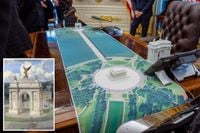President Donald Trump has ignited a fierce debate in Washington, D.C., after unveiling plans for a monumental triumphal arch to commemorate America’s 250th anniversary in 2026. In a wordless after-midnight social media post on October 11, 2025, Trump shared a rendering of the proposed structure, designed by Harrison Design and architect Nicolas Leo Charbonneau, sparking immediate controversy and comparisons to some of the world’s most iconic—and contentious—monuments.
The proposed arch, inspired by Brooklyn’s Soldiers’ and Sailors’ Memorial Arch and Paris’s Arc de Triomphe, would rise just across the Potomac River from the Lincoln Memorial in Arlington, Virginia. According to The Architect’s Newspaper and The Washington Post, the design features a gold-winged angel brandishing a scepter atop the arch, flanked by two huge eagles facing east. Carved wreaths and other classical elements complete the dramatic vision. The monument would soar above the Lincoln Memorial’s 99-foot height, making it one of the most prominent features of the capital’s skyline.
The location is no accident. Memorial Circle, the planned site, sits at the symbolic intersection of the Lincoln Memorial, Arlington House, and Arlington National Cemetery—ground that many consider the nation’s most hallowed. The arch would stand on undeveloped land inside a grass-covered traffic circle, directly across the Arlington Memorial Bridge from the Lincoln Memorial and just steps from Arlington House, the former home of Robert E. Lee and now a memorial to George Washington.
But not everyone is celebrating. Critics, including architect and former educator Eric Jenkins, warn that the arch could "disrupt a symbolic connection" between these historic sites. Jenkins, who has taught at the University of Maryland and Catholic University and is well-versed in Greco-Roman architectural traditions, minced no words when speaking to The Architect’s Newspaper. He argued, "Connection is the key—linking, bridging, reconciling. That’s what the Memorial Bridge does. It unites Lincoln’s legacy with Arlington, once home to Robert E. Lee, now a site of national mourning. The arch would more than likely obscure John F. Kennedy’s eternal flame that can be seen from the Lincoln Memorial on dark nights." Jenkins continued, "Inserting a grand, false monument into that axis and space breaks that symbolism. It risks replacing subtlety with spectacle, solemnity with show. Instead of healing, it imposes."
Jenkins’s concerns are echoed by others who point out that the model shown to the public had the Lincoln Memorial facing the wrong way, and social media users drew sometimes extreme comparisons to the grandiose, authoritarian designs of Nazi-era architect Albert Speer. The symbolism of the site and the scale of the project have become lightning rods for debate, with some seeing the arch as an imposition rather than a tribute.
Yet, the idea of a monumental arch in the nation’s capital is not new. Early 20th-century city planners, including those behind the 1901 McMillan Plan, dreamed of a Paris-style triumphal arch in Washington, D.C., though it was never realized. More recently, in 2000, the National Monuments Foundation proposed the Millennium Gate at Barney Circle, but that project was shelved due to traffic concerns and the changed national mood after 9/11. Art critic Catesby Leigh, who has long advocated for such a structure, described Memorial Circle as a "conspicuous dead space" that could be enlivened by a grand monument. "Washington is the only major Western capital without a monumental arch," Leigh wrote in an April op-ed.
Supporters of the current proposal say it’s time for Washington to embrace its own grand arch. Justin Shubow, president of the National Civic Art Society, presented the idea to Trump and reported that the president and others were enthusiastic. As Fox News reported, architect Nicolas Charbonneau, a partner at Harrison Design whose portfolio includes sacred architecture, has been sharing images and studies of the arch since September 2025. A source familiar with the project told The New York Post, "He’s an extremely talented classical architect... truly a classical architect, not just some guy who’s copying and pasting columns."
The arch is just one part of a broader transformation of the White House and the capital’s ceremonial core under Trump’s watch. Since returning to the White House in January 2025, Trump has overseen a design spree: redecorating the Oval Office with gold accents and new flags, transforming the Rose Garden with white paving stones and resort-style furniture, and beginning construction of a $200 million, 90,000-square-foot East Wing ballroom inspired by the Gilded Age. The ballroom alone will house a 25,000-square-foot event space, larger than the White House’s executive residence. Trump has also overseen installation of a pair of 88-foot flagpoles north and south of the White House and ordered the creation of a "Garden of Heroes." His administration has signaled a strong preference for classical architecture in federal buildings, seeking to reverse the trend of brutalist structures from the 20th century.
Trump’s ambitions for the nation’s 250th birthday go beyond architecture. According to The New York Post, he plans a year filled with celebratory events, including a Mixed Martial Arts fight to be hosted at the White House, underscoring his penchant for spectacle and showmanship. The arch, whether temporary or permanent, is meant to serve as a focal point for these celebrations. While the original America 250 arch was intended as a temporary structure, White House officials are now considering a permanent installation, according to Fox News.
Information about the cost, construction timeline, and funding for the arch remains scant. The White House has not responded to requests for comment, and the lack of details has only fueled speculation and debate. Some critics, including Democrats, have suggested that the new ballroom and other renovations are intended to serve Trump’s personal ambitions, possibly even for a third presidential term. Others see the projects as an attempt to leave an indelible mark on the capital’s landscape.
Meanwhile, practical concerns abound. Memorial Circle is a heavily trafficked area, raising questions about accessibility and safety. Jenkins and others argue that a monumental arch would be both inaccessible and out of place in such a busy location. The lessons of the Millennium Gate proposal in 2000, which was abandoned due to similar concerns, loom large in the background.
As America approaches its 250th anniversary, the debate over how best to commemorate the occasion is heating up. The proposed arch—grand, controversial, and undeniably ambitious—has become a flashpoint for broader questions about national identity, public space, and the legacy of presidential power. Whether the arch will rise above the Potomac as a new symbol of American triumph or remain a contested vision on paper, one thing is certain: it has already succeeded in capturing the country’s attention.





